#Lualaba
Text
Lualaba PDL145T : Réception technique de l'EDAP MUSUMBA (Territoire de Kapanga)
Le Bureau Central de Coordination (BCECO) a réceptionné techniquement en date du 24 juillet 2023, l’école d’application PUSUMBA dans la Province de Lualaba. Territoire de Kapanga, territoire de Kapanga, chefferie Mwant Yav.
Ces travaux sont exécutés dans le cadre du Programme de Développement Local des 145 Territoires du président de la République et Chef de l’Etat, Félix Antoine…
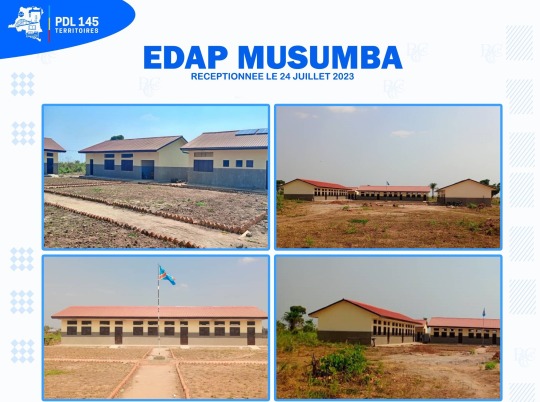
View On WordPress
0 notes
Photo

@ymbofficiel #color #davinci #lubumbashi #lualaba #kolwezi #music (à Kolwezi, DRC) https://www.instagram.com/p/CnFnTQZsGhY/?igshid=NGJjMDIxMWI=
1 note
·
View note
Text
RDC : au Lualaba, Félix Tshisekedi exprime son intention de transformer Kolwezi et d'en faire l'Europe du Congo
Félix Tshisekedi séjourne dans l’ex-Katanga où il est allé inaugurer plusieurs infrastructures d’intérêt commun.
Face à une foule compacte venue à sa rencontre, d’abord à Kasumbalesa, dans le Haut-Katanga, ou encore à Kolwezi, dans le Lualaba, le chef de l’Etat n’a pas raté l’occasion d’envisager l’avenir.
Alors que les élections générales auxquelles il prendra part sont prévues dans 3 mois, le…

View On WordPress
0 notes
Text

Amazing Malachite, Mashamba West Mine, Kolwezi mining district, Lualaba, DR Congo.
Photo ©️ @crystal.classics
214 notes
·
View notes
Text
A new rock for our personal collection! This piece contains the uranium minerals metatorbernite, uranophane, Cuprosklodowskite, and the copper mineral digenite from Musonoi mine, Kolwezi, Mutshatsha, Lualaba, Democratic Republic of the Congo. This is a specimen from the collection of Henri Vandormael, geologist at the Musonoi mine and other Congolese mines for the Union Miniere Haut Katanga (UMHK) company in the 1960’s, 70’s and 80’s. This company and their mines supplied much of the uranium that was used in the Manhattan Project in the 1940s.
BTW, I’ve worked with radioactive materials for the last 35 years. Samples like this need to be managed with care and respect. This is naturally-occurring radioactive material and it is completely legal to own.
#radioactive #radioactiveminerals #minerals #crystals #uranium #mineralcollection #uniquecollection #rockcollection
9 notes
·
View notes
Text
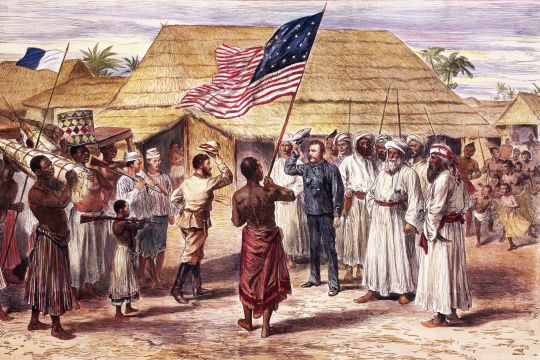
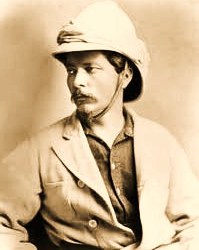

**November 10th 1871 saw the Journalist Henry M Stanley find the missing Scottish missionary David Livingstone with the classic “Dr Livingstone, I presume?”**
In 1867, Henry Stanley became special correspondent for the New York Herald and two years late would be sent to Africa in search of the legendary explorer David Livingstone.
Livingston had been following his obsessional search to find the sources of the Nile River and no one had heard from him for three years.
Stanley got to Zanzibar in 1871 and headed out on a 700 mile trek through tropical rainforest. Because the Herald had not sent the money promised for the expedition he borrowed in from the US Consul. He used this cash to hire over 100 porters for the expedition.
The trip did not go well. During the expedition through the tropical forest, his thoroughbred stallion died within a few days after a bite from a tsetse fly. Many of his porters deserted, and the rest were decimated by tropical diseases.
Seven months after arriving in Zanzibar Stanley found Dr Livingstone near Lake Tanganyika in present-day Tanzania and greeted him with the famous quote: “Doctor Livingstone, I presume?” Or did he?
There is some doubt about whether the line was actually ever said.
Henry Morton Stanley was born John Rowlands on 28th January 1841 in Denbigh, Wales. His parents were not married, and he was brought up in a workhouse. In 1859, he left for New Orleans. There he was befriended by a merchant, Henry Stanley, whose name he took. Stanley went on to serve on both sides in the American Civil War and then worked as a sailor and journalist.
In 1867, Stanley became special correspondent for the New York Herald. Two years later he was commissioned by the paper to go to Africa and search for the missionary and explorer David Livingstone, of whom little had been heard of for over a year, when he had set off to search for the source of the Nile.
Stanley reached Zanzibar in January 1871 and proceeded to Lake Tanganyika, Livingstone's last known location. There in November 1871 he found the sick explorer, greeting him with the now disputed words: 'Dr Livingstone, I presume?' Stanley's reports on his expedition made his name.
When Livingstone died in 1873, Stanley resolved to continue his exploration of the region, funded by the Herald and a British newspaper.
He explored vast areas of central Africa, and travelled down the length of the Lualaba and Congo Rivers, reaching the Atlantic in August 1877, after an epic journey that he later described in 'Through the Dark Continent'.
Failing to gain British support for his plans to develop the Congo region, Stanley found more success with King Leopold II of Belgium, who was eager to tap Africa's wealth. In 1879, with Leopold's support, Stanley returned to Africa where he worked to open the lower Congo to commerce by the construction of roads. He used brutal means that included the widespread use of forced labour. Competition with French interests in the region helped bring about the Berlin Conference (1884-1885) in which European powers sorted out their competing colonial claims in Africa. Stanley's efforts paved the way for the creation of the Congo Free State, privately owned by Leopold.
In 1890, now back in Europe, Stanley married and then began a worldwide lecture tour. He became member of parliament for Lambeth in south London, serving from 1895 to 1900. He was knighted in 1899. He died in London on 10 May 1904.
15 notes
·
View notes
Photo
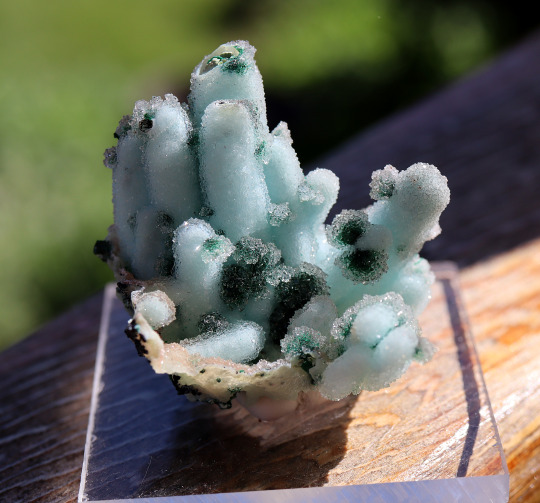
Fingers of sparkling Quartz over Chrysocolla ps. Tenke-Fungurume, Kolwezi, Lualaba, DR Congo
https://etsy.me/3OclIRj
37 notes
·
View notes
Text
ABUJA, Nigeria (AP) — The mining of minerals critical to electric vehicle batteries and other green technologies in Congo has led to human rights abuses, including forced evictions and physical assault, according to a new report from Amnesty International and another rights group.
Congo is by far the world’s largest producer of cobalt, a mineral used to make lithium-ion batteries for electric vehicles and other products, and it is also Africa’s top producer of copper, which is used in EVs, renewable energy systems and more.
Rights groups and U.S. officials have long criticized the trade of Congo’s cobalt, copper and other minerals due to abusive labor and the risk of violence in an impoverished central African country where militants control swaths of territory.
A measure was introduced in the U.S. House in July to ban imported products containing cobalt and copper and mined through child labor and other abusive conditions in Congo.
The report released Tuesday by Amnesty International and the Congo-based Initiative for Good Governance and Human Rights, or IBGDH, details how the search for the minerals has forcibly uprooted people from their homes and farmland, often without compensation or adequate resettlement.
The groups said they interviewed 133 people affected by evictions related to cobalt and copper mining in six locations around the city of Kolwezi in Lualaba Province during separate visits in February and September 2022. They also reviewed documents, photos, videos, satellite images and company responses.
The report highlights the numerous human rights violations that have occurred as a result of mining activity.
In one case, Congolese soldiers burned down the Mukunbi settlement in the southern province of Lualaba in November 2016 to make way for cobalt and copper mining by Dubai-based Chemaf Resources.
Residents who tried to stop the military were beaten, according to the report. The fire, which left a 2-year-old girl with life-altering scars, and the assault had followed initial warnings delivered to residents by company executives escorted by police.
“Ernest Miji, the local chief, said that in 2015, after Chemaf acquired the concession, three representatives of the company, accompanied by two police officers, came to tell him it was time for Mukumbi’s residents to move away. He said the representatives visited four more times,” the report said.
Following protests in 2019, Chemaf agreed to pay $1.5 million through local authorities, with some former residents receiving between $50 and $300, which the local advocacy group Coalition for Safeguarding of Human Rights called an undervaluation of victims’ properties.
Chemaf denied any wrongdoing, liability or involvement in the destruction of Mukumbi or directing military forces to destroy it, the company told Amnesty International.
On its website, Chemaf says the copper and cobalt project is at the heart of its ambitious growth and would consolidate its position as a leader in the production of those minerals.
The report also highlighted a neighborhood in Kolwezi, home to 39,000 people, that has been facing continuous demolitions since 2015 to make way for an open-pit copper and cobalt mine. The mine is operated by Compagnie Minière de Musonoie Global SAS, or COMMUS, a joint venture between Chinese company Zijin Mining and the state-owned Gecamines mining company.
Those who were forced out said they were not adequately consulted, while COMMUS said it aimed to improve its communications, according to the report.
The company asserted that it already has made compensation payments calculated by the provincial government’s relocation committee to ensure residents' quality of life was not affected.
“The compensation prices of COMMUS for housing and land were higher than market prices,” according to a letter that the company sent to the rights groups.
But the groups denied it was enough.
“Despite claims by the company that its compensation package was set to ensure living standards were not affected, none of the former residents of Cité Gécamines that researchers interviewed said that they were able to afford substitute housing with the same amenities as the houses that they were forced to leave,” the report said.
Donat Kambola, president of the IBGDH group that co-wrote the report, said in a statement that “people are being forcibly evicted, or threatened or intimidated into leaving their homes, or misled into consenting to derisory settlements. Often there was no grievance mechanism, accountability, or access to justice.”
Amnesty International says companies are not doing enough to address human rights concerns and are disregarding international human rights laws and standards, as well as national legislation and U.N. Guiding Principles on Business and Human Rights.
As the world demands more green technologies to reduce climate-changing emissions, the extraction of minerals for these products is causing social and environmental harm, the group said.
“Amnesty International recognizes the vital function of rechargeable batteries in the energy transition from fossil fuels. But climate justice demands a just transition. Decarbonizing the global economy must not lead to further human rights violations,” it said.
14 notes
·
View notes
Text
#unhallowedarts "Try to be Civil, Marlow" - Joseph Conrad's "Heart of Darkness"

“We live as we dream--alone....” (Joseph Conrad)
He did turn fresh-water sailor himself once, after sailing the seven seas for 15 years, finally making “master” on the barque “Otago” of the British Merchant Navy, carrying goods on the South Australia run back in the late 1880s. The Polish-born skipper of a riverboat steaming up the Lualaba towards the Belgian government station at Kisangani below the Stanley Falls found the grave and the tale of a bad white man gone to worse in Central Africa, in the hell of King Leopold II’s so called Congo Free State. It might be that the aspiring author had heard the enthralling voice of Mr Kurtz there for the first time. Almost a decade later, when the jolly tar brought his experiences to paper, the voice had received the superstructure of a Nietzschean Übermensch, the psychological abyss of Dostoevsky’s outré protagonists and Captain Ahab’s hubris. A man who founders in the Heart of Darkness, the distorting mirror Africa had become for Europe’s cloud-cuckoo-land at the end of the long 19th century. The only remedy against things falling apart, the centre that just might hold, were the seamannish virtues of the tale’s narrator, idealised by its author, Joseph Conrad. But Conrad always was a novelist who went to sea instead of a seaman who became an author.

Many of Conrad’s tales might look like tarry, rough handed sailors at first acquaintance, but they soon take on the guise of Marlow, his narrator oftimes, sitting on deck of the Nellie riding at anchor in Gravesend, spinning his yarn, with “sunken cheeks, a yellow complexion, a straight back, an ascetic aspect, and, with his arms dropped, the palms of hands outwards,” resembling “a Buddha preaching in European clothes and without a lotus-flower. And no balm in Gilead either. “Heart of Darkness” barrages the reader with imagery from Dante to the more sinister aspects of Greek mythology along with the cold and lofty heights of contemporary European literature. A climate no one escapes alive. Or at least not sane. “He cried in a whisper at some image, at some vision—he cried out twice, a cry that was no more than a breath:
“‘The horror! The horror!’”
But then, Conrad’s Africa is a distorting mirror all by itself and the novelette is not so much describing things as they were – even though Conrad manages to do that well enough. The “Heart of Darkness” is not discovered in foreign climes but too close for comfort and travelling on an actual river might never be the same after reading Conrad, the tale told is a Campbellian journey inwards.
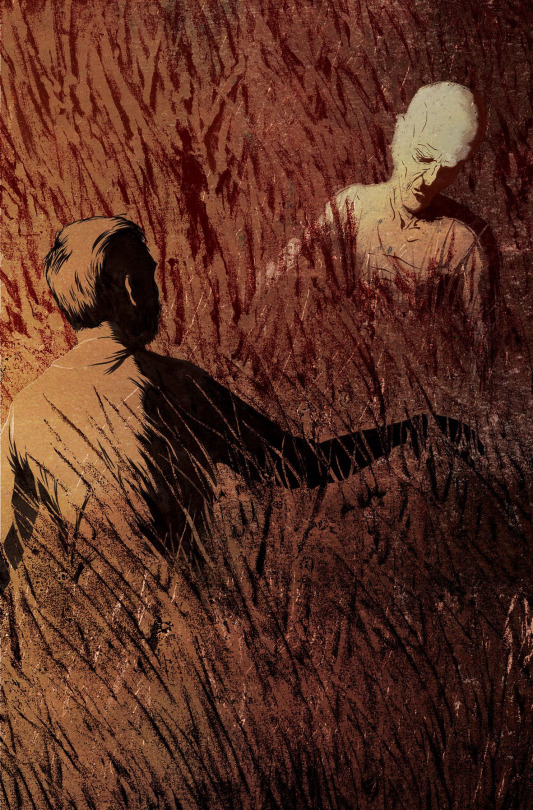
He indulged himself in the abyss of the human soul, seen and heard in Conrad’s work, but very rarely voiced in single arias with all highs and lows, standing out from the choir of highly polyphonic arrangements, like Dostoevsky’s. It’s a horror, and that’s that. With a surprisingly simple remedy: “Try to be civil, Marlow“, despite the tragédie humaine Conrad usually narrates. And while his matchless prose with all its Gallicisms, Polonisms and artificially wonderful word and grammar structures and creations no native speaker could come up with remains unrivalled, his influence, at the very least through his rich imagery. Seen and distorted into Symbolist visions, garnished with enchanting, often disturbing and sometimes misleading adjectives, a realist author with a very, very deep cargo hold.
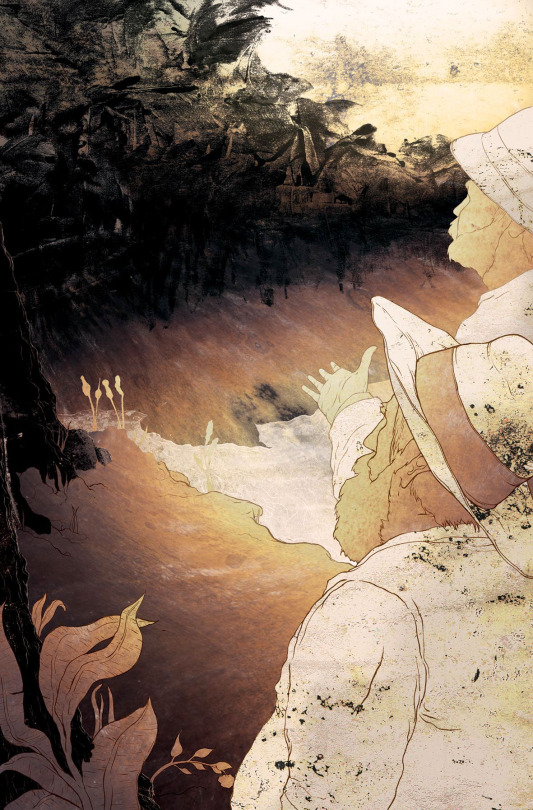
All images above were created by Sean McSorley for the Folio Society's 2014 edition of Joseph Conrad's "Heart of Darkness", a gem that can be acquired following the link below - and where McSorley excellent - and quite congenial - artwork was nicked from.
#unhallowedarts#dark literature#dark aesthetic#classic fiction#classic literature#joseph conrad#heart of darkness
11 notes
·
View notes
Text
[…] Indispensable à l'industrie, notamment à la fabrication des batteries qui équipent les véhicules électriques, le cobalt est devenu un minerai hautement stratégique. De la République démocratique du Congo à la Scandinavie, une remarquable enquête sur la face cachée de son extraction.
Pour atteindre la neutralité carbone à l'horizon 2050, l'Union européenne a décidé d'interdire à partir de 2035 la vente des véhicules neufs à moteur thermique ou hybride. Un défi pour l'industrie automobile du continent, tenue de développer sa production de voitures et d'utilitaires légers 100 % électriques. Associé au lithium, au nickel et au manganèse, le cobalt assure la stabilité des cellules des batteries et empêche qu'elles n'entrent en combustion. Avec l'accélération de la mobilité électrique, ce sous-produit de l'extraction du cuivre est devenu un minerai hautement stratégique. Ses plus grands gisements mondiaux se trouvent en République démocratique du Congo (RDC), dans les provinces du Lualaba et du Haut-Katanga. Si les investisseurs étrangers, principalement chinois, y contrôlent les trois quarts des sites miniers industriels, 20 % des mines y sont artisanales, principalement autour de la ville de Kolwezi : parfois âgés de moins de 10 ans, des "creuseurs" y risquent leur vie dans des boyaux de fortune pour des rétributions misérables. En quête de souveraineté pour s'affranchir du quasi-monopole de la Chine dans la fourniture de batteries, l'Europe encourage de son côté la multiplication des projets miniers sur son territoire afin d'alimenter les chaînes de production qu'elle compte développer.
Batterie de fléaux
Pollution à l'acide des sols et des cours d'eau, expropriation de leurs terres des paysans et des éleveurs, travail des enfants, corruption des élites pour l'octroi de permis d'exploitation...: en RDC, la course au cobalt - chaque batterie en nécessite 10 kilos - s'accompagne d'une cohorte de fléaux. En Scandinavie, où les principaux gisements européens ont été identifiés, ce sont les risques environnementaux qui suscitent les craintes des populations locales. Donnant la parole à des industriels de l'automobile et du secteur minier, au vice-président de la Commission européenne Maros Sefcovic, à des ONG et à des activistes engagés dans la défense des droits humains et la protection de l'environnement, cette enquête remarquable pointe la face cachée d'un marché stratégique, dont la demande est promise à une croissance exponentielle pour réaliser le rêve européen de neutralité carbone.
Réalisation: Quentin Noirfalisse, Arnaud Zajtman (2022)
#cobalt#lithium#arte#impérialisme#néocolonialisme#catastrophe écologique#catastrophe humaine#batteries
5 notes
·
View notes
Text
Lualaba- Kolwezi : La Gouverneure Fifi Masuka Saïni encouragée par l'évêque de Kolwezi pour son appui à l'œuvre ecclésiastique.
Le Domaine Marial de KOLWEZI a abrité ce dimanche 22 septembre 2024 la célébration Eucharistique marquant l’ouverture de l’année pastorale 2024-2025 du Diocèse de KOLWEZI, chef-lieu du LUALABA. De nombreux fidèles catholiques des différentes paroisses et chapelles du Diocèse ont répondu à l’appel de leur évêque.
Accompagnée de quelques membres de son cabinet et de son gouvernement, la…
0 notes
Text
Kolwezi : Affrontement Sanglant à la Carrière RULCO – Les Militaires et les Chinois Accusés de Déloger les Creuseurs Artisanaux
La tension est montée d’un cran à Kolwezi, dans la province du Lualaba, où les militaires, en soutien à l’entreprise minière chinoise KINGA KILA, ont violemment déguerpi les creuseurs artisanaux de la carrière RULCO, située sur le site de la Gécamines à Luilu. Ce déguerpissement forcé, survenu dès 00h00 ce lundi, a rapidement tourné à l’affrontement, plongeant la région dans le chaos.
Depuis…
0 notes
Text
Rdc - Lualaba : État des lieux du secteur minier au cœur d'une séance de travail entre le ministre des mines et la gouverneure de la province
En compagnie d’une forte délégation, le Ministre des Mines est arrivé à KOLWEZI dans le Lualaba en début de soirée de ce jeudi 15 août 2024.Accueilli au pied de l’avion par le Vice-Gouverneur de Province Clément MUFUNDJI TSHINAT KARL, KIZITO PAKABOMBA KAPANGA a immédiatement été conduit au Gouvernorat pour une séance de travail avec la Gouverneure de Province et les responsables des services…
0 notes
Text
RDC : au Lualaba, Félix Tshisekedi exprime son intention de transformer Kolwezi et d'en faire l'Europe du Congo
Félix Tshisekedi séjourne dans l’ex-Katanga où il est allé inaugurer plusieurs infrastructures d’intérêt commun.
Face à une foule compacte venue à sa rencontre, d’abord à Kasumbalesa, dans le Haut-Katanga, ou encore à Kolwezi, dans le Lualaba, le chef de l’Etat n’a pas raté l’occasion d’envisager l’avenir.
Alors que les élections générales auxquelles il prendra part sont prévues dans 3 mois, le…

View On WordPress
0 notes
Text
Lualaba : "Aucune activité de l'ABD est prevue ce mercredi à Kolwezi" (mise au point)
“Absent de Kolwezi, l’Hon. Jean-Marie Tshizainga présidé aucune réunion préparatoire, et aucune activité politique est prévue ce mercredi 24 avril à Kolwezi. Le parti ABD est concentré aux élections des sénateurs et des gouverneurs prévues le lundi prochain.” Peut-on lire dans le communiqué de presse de la cellule de communication.
Lualaba: L’initiateur Fondateur de l’ABD Jean-Marie TSHIZAINGA…

View On WordPress
0 notes
Text
Specimen from the Shangulowé mine, where we see a series of Chrysocolla crystalline aggregates formed after the crystallization of malachite in matrix, in the form of spheroidal nodules of intense green color with multiple needles giving shape to the spheres. A piece of extraordinary beauty from such a unique mine in the Congo. Methacrylate base is included.
0 notes